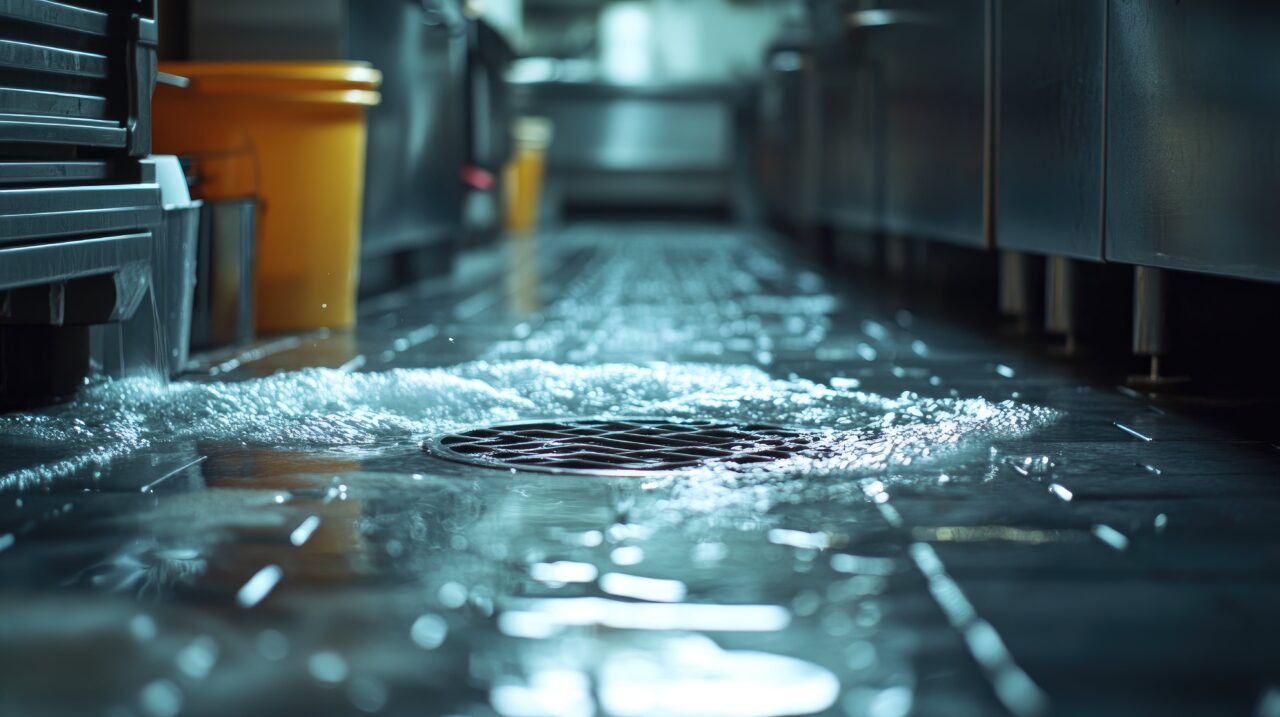To unclog the floor drain in your restaurant kitchen, you need the right process and the right
precautions. This guide walks you through every method that actually works in commercial
kitchens.
Behind every clogged drain is a bigger risk: Slips, citations, downtime, and preventable profit
loss. So, we’ll also cover what’s causing the blockage in the first place, how to prevent it from
coming back, and when a licensed plumber is the safer move.
Let’s start with what you can do right now to get things flowing again.
Step-by-Step Process to Unclog Restaurant Floor Drains
To unclog a floor drain in a restaurant kitchen, start by identifying what’s causing the blockage
(grease, food sediment, or a deeper backup) and use a method that fits both the problem and
your pace of service.
Use hot water to break down fat, a plunger or auger for obstructions, a wet/dry vacuum to
extract buildup, and enzyme treatments for long-term effect.
For severe backups or repeated grease clogs, hydro jetting may be needed.
If that’s happening more often than it should, your grease trap might be part of the problem. If
it’s more than 25% full or hasn’t been cleaned in the last 30 days, it could be sending fats
downstream and fueling repeat clogs.
Throughout the process, protect your team and maintain sanitation: Mark wet floors, wear
gloves, and shut off nearby dish machines.
Here’s the step-by-step process for each method:
Hot Water Flush with Degreaser Soak
Pour boiling water directly into the drain, followed by a commercial degreaser or bio-enzymatic
cleaner. Let it sit for at least 15 minutes, then flush again with boiling water. This helps soften
cooled and hardened grease and food buildup that coats the drain walls. This is often the
easiest way to restore flow.
Plunger for Surface-Level Clogs
Use an industrial cup plunger with steady, even pressure. Plunge with firm vertical strokes for
20-30 seconds. If the clog is near the surface, this should dislodge it quickly. Repeat several
times, then flush again with hot water.
Drain Auger for Deeper Obstructions
If plunging doesn’t work, feed a ⅜-inch cable hand auger 2-3 feet down the pipe while rotating
clockwise. If it snags, back it out, clean the head, and reinsert. Avoid forcing the cable, because
this can damage older pipes.
Wet/Dry Vacuum Extraction
Set a wet/dry shop vacuum to wet mode. Cover the drain grate with the mouth of the hose and
seal with a towel. Listen as you suction (gurgling means you're pulling out buildup). This works
well for soft blockages or after loosening material with other methods.
Enzyme Treatment (Overnight)
For ongoing buildup, pour enzyme drain cleaner into the drain before close. Let it sit overnight.
These cleaners digest organic waste, rather than pushing it down. It also helps reduce smells.
Hydro Jetting (Professional Only)
If grease has made it past your trap and backups keep happening, it’s time to call a licensed
plumber for hydro jetting. A trained plumber will use pressurized water to clear grease, scale,
and buildup, stripping the entire line clean and restoring full pipe flow.
If hydro jetting is what you need, it might be a good time to revisit your commercial sewer
cleaning schedule to prevent deeper backups before they start.
If you’re still having issues after jetting, the problem might be the pipes themselves. Older or
poorly sloped lines can cause waste to settle and harden, no matter how often you clean.
What You’ll Need to Unclog a Restaurant Floor Drain
Before you start clearing that backup, make sure your team has the right tools on hand so a
small clog doesn’t become much worse. All of these should be stored in an easy-to-access
place for whenever a clog hits:
- Protective gear: Gloves, goggles, and non-slip shoes. Grease and wet floors are a
dangerous combination. - Bio drain cleaner or enzyme solution: Use a commercial-grade product designed to
digest organic waste. - Industrial plunger: A short-handled, heavy-duty cup plunger gives you more control.
- ⅜” cable drain auger: Essential for reaching clogs deep in the pipe without damaging it.
- Wet/dry vacuum: Suctions out soft buildup after flushing or plunging.
- Bucket, long-handled brush, squeegee: Keep the area safe and dry while you work.
Restaurants spend $28 billion on repairs and lose $46 billion in downtime every year. A few of
these low-cost tools can prevent a whole lot of profit from leaking out through the floor drain.
We should also mention that standing water and dirty drains attract flies and roaches. Keeping
your drains clean and dry is one of the easiest ways to support your pest prevention strategy.
Why Restaurant Floor Drains Clog
Restaurant kitchen floor drains clog when fats, solids, and buildup accumulate inside the pipe
and slow or stop flow. Daily prep, dishwashing, and fryer cleanouts send everything from grease
to food scraps into the drain. Without strict habits to intercept or flush that buildup, it turns into a
full blockage, usually during your rush.
Here’s what typically causes a restaurant floor drain clog:
Grease & Fat Accumulation
Fryer grease and grill runoff cool fast and harden inside the pipe. Even if it’s rinsed with hot
water, enough buildup over time creates a thick ring that chokes the drain during service.
Food Debris & Sediment
Dropped rice, cheese, chicken bones … when plates are scraped directly into sinks, those
solids pile up in the drain trap. Even small scraps from floor sweeping or sink overflows can
build up if drain baskets are missing or left unemptied.
Soap Residue & Scum
Heavy detergent use at the dish station leaves behind thick suds that bind with fat and food
particles, creating a sticky sludge that clings to pipes and traps.
Mineral Scale (Especially in Hard Water Regions)
If your water leaves white rings on your faucets, it’s doing the same thing inside your pipes. These mineral deposits lead to scale, adding a roughness in the pipes that traps more debris. This narrows the drain opening, making clogs more likely and harder to clear.
Foreign Objects
Utensils, wrappers, gloves, cocktail straws, even twist ties … we’ve pulled all of it from
commercial drains. Anything small enough to slip through the floor grate can become the root of
a blockage.
Preventive Maintenance and Compliance Tips
To prevent future restaurant floor drain clogs, you need consistent habits that reduce buildup
before it has a chance to block flow. One backup during service is enough to sideline your dish
station, trigger a slip-and-fall incident, or flag you on a health inspection.
Daily wear is unavoidable, but a few simple routines keep your drains ready and your staff
moving.
Here’s what that looks like in practice:
- Weekly enzyme dosing: Add a scheduled enzyme soak after close once a week. It
breaks down food and grease buildup before it hardens. - Stainless steel drain baskets: Removable, cleanable strainers catch scraps before
they hit the trap. Check and empty them every shift. - Plate scraping and proper grease disposal: Train your team to scrape solids into
compost or trash and dump grease in a designated container (never the sink or floor
drain). - End-of-day boiling water flush: Boiling water poured down floor drains nightly keeps
residue from sticking and prevents smells. - “Clog log” for inspections: Document clogs, cleanings, and enzyme treatments. It
shows inspectors you’re proactive and helps catch patterns early.
Whenever possible, time your deep cleanings, enzyme treatments, and jetting appointments for
after close or before prep. That way, your crew isn’t working around hoses or wet floors when
the rush hits.
Routine maintenance like this can cut equipment costs by up to 50% and extend the life of your
plumbing systems by 25%. In industries like restaurants and hospitality, where margins are
notoriously thin, cutting avoidable costs like this can make a real difference in monthly
profitability.
If your team needs help locking in a reliable routine, our Facilities Management and Maintenance Plans can integrate these tasks into a regular schedule.
When to Call a Professional Commercial Plumber
You should call a plumber when your team has done everything they can, and the floor drain
still backs up, smells, or slows service. One clog you can’t clear is a hassle. Two or three? It’s
time for professional help.
If your team has flushed, plunged, vacuumed, and enzyme-soaked the line more than once and
the flow still isn’t normal, that’s your cue.
Other red flags include:
- Sewage or grease trap overflow
- Strong odors coming from your drains (often a sign of biofilm buildup or blocked vent
lines) - Visible water backing up
If you can’t locate the clog or you’re worried it’s further down than your auger can reach, a
plumber can run a camera inspection and determine if hydro jetting is the next step.
And the sooner you call, the less damage it causes.
Unplanned downtime eats up 1-10% of production time, and most operators underestimate what
that actually costs. You’re dealing with customers waiting on food, staff working in unsafe or
unsanitary conditions, potential code violations, and lingering smells that tank the dining
experience and your online reviews. Mold and water damage don’t take long to set in, either.
If it’s beyond what your team can handle, our 24/7 plumbing team helps restore flow fast, keeps
you compliant, and prevents repeat issues that hurt revenue.
Why Partner with Us for Drain Maintenance?
Partnering with us means you don’t have to choose between short-term fixes and long-term
reliability. We help restaurants avoid the chain reaction that starts with a clogged drain and ends
in downtime, citations, or bad reviews.
Even one missed backup can eat into your bottom line, and at an average 3-5% margin, one
clog during dinner service can wipe out a month’s profit.
Since 1944, we’ve supported high-volume restaurants with services built for the realities of
commercial kitchens, including:
- 24/7 licensed, insured plumbers in Tennessee, Kentucky, Alabama, and Georgia
- Preventive jetting, grease line maintenance, and camera inspections
- Maintenance Plans tailored to your kitchen’s workflow
When you need help fast or want a partner to prevent problems before they start, we’ve got you
covered.
Don’t let a drain clog shut down your service. Contact Lee Company to schedule preventive
care or emergency plumbing today.
Ready for clean pipes?
CALL US NOW AT 615.567.1000

